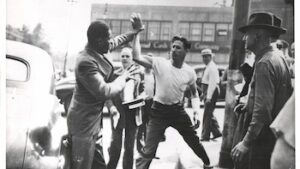
The 1943 Detroit Race Riot
*On this date in 1943, the Detroit race riot took place. This was a two-day episode of racial unrest in Michigan's largest city.
By 1920, Detroit had become the fourth-largest city in the United States, driven by an industrial and population boom fueled by the rapid expansion of the automobile industry. In this era of continuing high immigration from southern and eastern Europe, the Ku Klux Klan (KKK) established a substantial presence in Detroit during its early 20th-century revival. The KKK and its lesser-known offshoot, Black Legion, became concentrated in midwestern cities and the South. It was primarily anti-Catholic and anti-Jewish in this period, but it also supported white supremacy.
Detroit was unique among northern cities by the 1940s for its exceptionally high percentage of Southern-born residents, both Black and White. In 1936 and 1937, some 48 Klan members were convicted of numerous murders and attempted murders, thus ending the Black Legion's run. Soon after the U.S. entered World War II, the automotive industry was converted to military production, offering high wages that attracted large numbers of workers and their families from outside Michigan. The new workers found little available housing, and competition among ethnic groups was fierce for jobs and housing.
With Executive Order 8802, President Franklin D. Roosevelt, on June 25, 1941, prohibited racial discrimination in the national defense industry. Roosevelt called upon all groups to support the war effort. The executive order was applied irregularly, and Blacks were often excluded from numerous industrial jobs, especially more skilled and supervisory positions. The rioting in Detroit began among youths at Belle Isle Park and spread to other areas of the city, and was exacerbated by false rumors of racial attacks.
The riot escalated after a false rumor spread that a mob of whites had thrown a black mother and her baby into the Detroit River. Blacks looted and destroyed white property as retaliation. Whites traveled long distances across the city to join the first stage of the riot near the bridge to Belle Isle Park, and later, some traveled in armed groups explicitly to attack the black neighborhood in Paradise Valley. At the time of the riot, a dramatic population increase and social tensions were associated with the military buildup of U.S. participation in World War II.
At the same time, Detroit's automotive industry was converted to the war effort. Social tensions and housing shortages increased due to racist feelings about the arrival of nearly 400,000 migrants, both Black and White Southerners, from the Southeastern United States between 1941 and 1943. The migrants competed for space and jobs against the city's residents as well as against European immigrants and their descendants. It continued until June 22 and was suppressed after 6,000 federal troops were ordered into the city to restore peace.
White commissions attributed the cause of the riot to Black people and youths. Still, the NAACP claimed affordable housing, discrimination in employment, a lack of nonwhite representation in the police, and white police brutality. The Detroit riot was one of five that summer; it followed others in New York City, Los Angeles, California, Beaumont, Texas, and Mobile, Alabama. A late 20th-century analysis of the rioters showed that the white rioters were younger and often unemployed (characteristics that the riot commissions had falsely attributed to blacks despite evidence to the contrary). If working, the whites usually held semi-skilled or skilled positions.
The Black participants were often older, established city residents who, in many cases, had lived in the city for more than a decade. They also looted and destroyed white-owned property in their neighborhood. A total of 34 people were killed, 25 of them Black, and most at the hands of the White police force, while 433 were wounded (75 percent of them Black), and property valued at $2 million (worth $30.4 million in 2020) was destroyed. Most of the riot occurred in the Black area of Paradise Valley, the poorest neighborhood in the city.